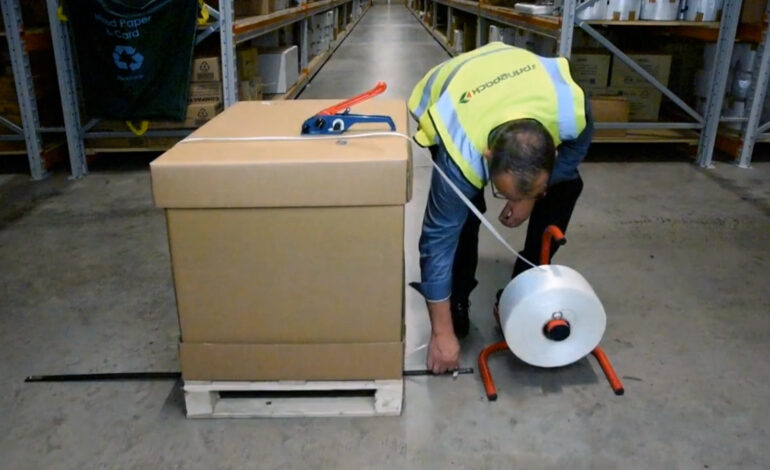
The Role of Pallet Strapping in Reducing Freight Damage Costs
Freight damage is more than just a minor hiccup in logistics; it can snowball into higher costs, customer dissatisfaction, and even reputational harm. No business wants to deal with unhappy clients or product losses, right? That’s why securing goods during transit is such a priority. Among the many methods available, pallet strapping stands out as an effective, reliable, and cost-efficient solution. If you’re not already using it or fully optimising its potential, you’re leaving room for preventable losses.
Why Freight Damage Costs So Much More Than You Think
When goods are damaged in transit, the impact isn’t limited to replacing or repairing them. Have you thought about the ripple effects? There’s the cost of reshipping, the extra labour for handling claims, potential refunds, and even damaged customer relationships. These are the kinds of costs that can eat away at your margins, even if they don’t show up on your balance sheet right away. Freight damage is avoidable in many cases, but it requires the right preventative measures—starting with how your goods are secured.
What Makes Pallet Strapping So Effective?
Pallet strapping works by tightly securing items to a pallet, minimising movement during transit. This simple action can significantly reduce the likelihood of damage caused by shifting loads. But what makes it such an efficient option compared to other methods?
● Strong support – Strapping can handle heavy loads and high tension, ensuring your items stay firmly in place.
● Versatility – Whether you’re dealing with boxes, barrels, or oddly shaped goods, strapping works across different packaging types.
● Cost-efficiency – Unlike some other methods that require costly equipment or excessive materials, strapping is affordable while still being highly effective.
● Environmental options – Many types of straps, such as polyester or polypropylene, can be recycled, aligning with sustainability goals.
● Customisability – Straps come in various strengths, widths, and materials to suit specific freight needs.
These advantages make pallet strapping an ideal solution for businesses seeking to reduce costs without compromising on security.
Common Mistakes to Avoid When Strapping Pallets
It’s not just about using pallet strapping; it’s about using it right. Have you ever seen pallets arrive with damaged goods despite being strapped? That often boils down to simple errors. Let’s address the most common ones.
- Using the wrong material – Straps made of polyester, polypropylene, or steel have different strengths and flexibilities. Using the wrong type could mean insufficient support or unnecessary expense.
- Improper tension – If the strap is too loose, goods can shift. Too tight? You risk damaging the packaging itself.
- Ignoring edge protection – Without corner protectors, straps can dig into boxes or create weak points.
- Not checking for wear and tear – Reusing worn-out straps may save a few dollars upfront, but it increases the risk of breakage during transit.
- Skipping proper training – Staff need to know how to use strapping tools and tensioners correctly. A quick refresher can make all the difference.
By avoiding these mistakes, you’ll maximise the effectiveness of pallet strapping and reduce the risk of freight damage.
What Kind of Strapping Should You Use?
Choosing the right type of strapping is key. The type of goods you’re shipping, their weight, and how far they’re travelling all influence your choice. Let’s break down the main options:
● Polypropylene (PP) straps – Lightweight, cost-effective, and great for lighter loads. They’re also recyclable, which is a bonus if sustainability matters to your business.
● Polyester (PET) straps – Stronger than polypropylene, these are ideal for medium to heavy loads. They offer excellent tension retention, making them a reliable choice for long-distance shipping.
● Steel straps – The heavyweight champion of the strapping world. Steel is the go-to for extremely heavy or rigid loads, where maximum durability is non-negotiable.
● Corded or woven straps – Flexible yet strong, these are often used for irregularly shaped goods. They’re also easy to handle without sharp edges.
Each type has its strengths, so the right choice depends on your specific freight needs. A quick assessment of your goods can help determine the most suitable option.
Tips for Getting the Most Out of Your Strapping
Once you’ve chosen the right straps, it’s all about maximising their potential. Here are some tips to ensure your strapping does the heavy lifting for you:
● Use quality strapping tools – Invest in tools like tensioners and sealers for optimal application. They might cost a little upfront, but they’ll save you time and effort.
● Inspect regularly – Always check straps for wear, tear, or incorrect application. A quick inspection can prevent costly damage later.
● Combine with other methods – Strapping works best when combined with stretch wrapping or shrink film for added stability.
● Secure the pallet base – Make sure straps loop around both the goods and the pallet base. This prevents the entire load from detaching in transit.
● Train your team – Well-trained staff can strap pallets quickly and effectively, ensuring consistency across shipments.
These steps may seem small, but they add up to significant improvements in freight safety and cost savings.
Why Strapping Matters for Your Bottom Line
At the end of the day, reducing freight damage isn’t just about saving money—it’s about operating more efficiently and keeping customers happy. Damaged goods lead to delays, extra costs, and potential reputation issues. By implementing pallet strapping properly, you can minimise these risks and focus on growing your business.
Think about it this way: every damaged shipment is a missed opportunity to impress your customer. Wouldn’t it be better to prevent the problem altogether? Pallet strapping gives you a simple, effective way to keep your goods secure and your costs down.
Securing Your Shipments, Securing Your Success
Pallet strapping might not seem like the most exciting part of logistics, but it’s certainly one of the most important. By using it effectively, you can dramatically cut freight damage costs, improve efficiency, and keep your customers happy. The question is: are you ready to take full advantage of it? Implement the tips shared here, avoid the common mistakes, and you’ll see the difference in both your operations and your bottom line.




